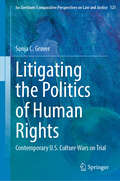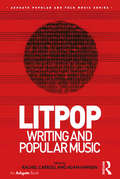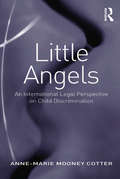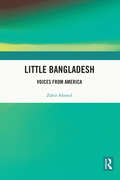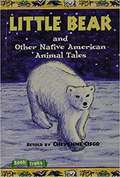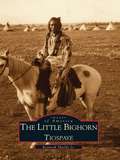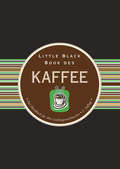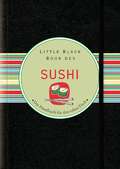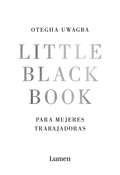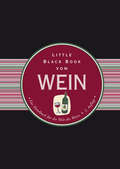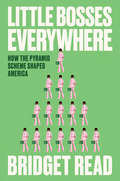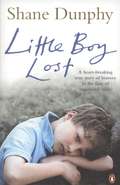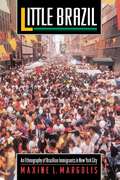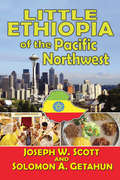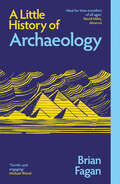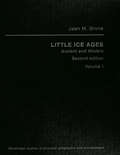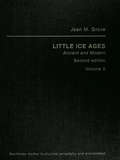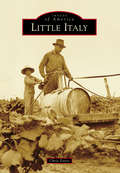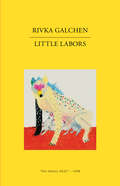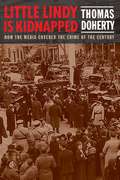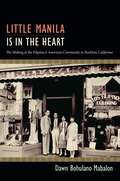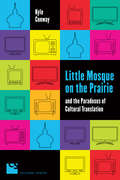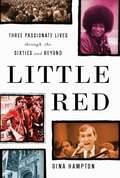- Table View
- List View
Litigating the Politics of Human Rights: Contemporary U.S. Culture Wars on Trial (Ius Gentium: Comparative Perspectives on Law and Justice #121)
by Sonja C. GroverThe cases analysed involve litigation concerning a disparate range of contemporary US culture wars including equity in access to public services unrestricted by religious bias, resistance to the teaching of historical facts relating to racial tensions in America including the so-called ‘critical race theory’ debate, the right of schoolchildren to exposure concerning a diversity of views, current USSC litigation about US university admissions policy that considers ‘race’ (ethnicity) as one factor amongst many in admission, contemporary cases concerning the constitutionality of US abortion law grounded on Roe v Wade and the scope of State and indigenous sovereign powers These contemporary culture war US landmark cases are then compared to similar cases in non-US jurisdictions and courts to consider in more depth the underlying core issues in these cases. The book highlights the risk to a democracy of recasting fundamental human rights litigation as essentially nothing more than the sorting out of political quagmires and cultural conflicts best left to the discretion of government rather than the courts. Then, the major risk is that constitutional controversies will increasingly not be decided by an independent judiciary but rather by self-interested politicians as the courts more often than not decline to weigh in on highly sensitive human rights controversies. A further risk is that instead such cases will be decided through a judicial majoritarian political lens rather than a largely apolitical consensus judicial opinion constructed by both philosophically left leaning (so-called liberal) and right leaning (so-called conservative) jurists.
Litpop: Writing And Popular Music (Ashgate Popular and Folk Music Series)
by Adam Hansen Rachel CarrollBringing together exciting new interdisciplinary work from emerging and established scholars in the UK and beyond, Litpop addresses the question: how has writing past and present been influenced by popular music, and vice versa? Contributions explore how various forms of writing have had a crucial role to play in making popular music what it is, and how popular music informs ’literary’ writing in diverse ways. The collection features musicologists, literary critics, experts in cultural studies, and creative writers, organised in three themed sections. ’Making Litpop’ explores how hybrids of writing and popular music have been created by musicians and authors. ’Thinking Litpop’ considers what critical or intellectual frameworks help us to understand these hybrid cultural forms. Finally, ’Consuming Litpop’ examines how writers deal with music’s influence, how musicians engage with literary texts, and how audiences of music and writing understand their own role in making ’Litpop’ happen. Discussing a range of genres and periods of writing and popular music, this unique collection identifies, theorizes, and problematises connections between different forms of expression, making a vital contribution to popular musicology, and literary and cultural studies.
Little Angels: An International Legal Perspective on Child Discrimination
by Anne-Marie Mooney CotterFollowing on from her previous nine books on discrimination law, Anne-Marie Mooney Cotter now focuses on the goal of child equality. Examining issues of child labour and the relevant laws which are designed to protect the most vulnerable in our society, the book explores the primary role of legislation and the judicial system and its impact on the fight for child rights and the ultimate goal of the end of inequality. The book considers the major common law countries of Australia and New Zealand, Africa and South Africa, Canada, Mexico and the United States, and the United Kingdom and Ireland, as well as the North American Free Trade Agreement and the European Union Treaty in a historical and compelling analysis of discrimination worldwide. By providing a detailed examination of child rights and the law, it will be an important read for those concerned with equality and empowering those most vulnerable to discrimination, the children.
Little Archaeologist (A Science Tots Book)
by Dan TaylorTeach your baby all about archaeologists with this new board book published in partnership with Smithsonian.Fossils. Shovels. Sieves. Brushes. These are all the important tools archaeologists use. In this new board book series published in conjunction with the Smithsonian Institute, young babies and toddlers will learn what an archaeologist does while enjoying playful art by Dan Taylor.
Little Bangladesh: Voices from America
by Zahir AhmedThis volume presents a comprehensive overview of the Bangladeshi diaspora in USA. Based on case studies from across Southern California, it discusses themes such as economic advantages of migration beyond sociological models of globalization; Bangladeshi diaspora and Little Bangladesh; oral histories of settlement and incoming migrants; imagined homelands in California; emigration and immigration; trans-business and the American Dream; diaspora and social media; Islam and transnationalism; and Bangladeshi Islam in the USA. It explores the trans-global subjectivity and embodied experiences of Bangladeshi migrants as they negotiate economic opportunity, security, and challenges. The book also documents transnational ties that migrants retain; the aspirations and anxieties they face; and what it means to be a Muslim living in the USA in the post-9/11 era. With its rich, multi-sited ethnographic narratives set in transnational studies and studies of globalization, this book will interest scholars and researchers of diaspora studies, migration studies, South Asian studies, political sociology, social anthropology, sociology and political studies, international relations and those interested in Bangladesh.
Little Bear: And Other Native American Animal Tales (Book Treks)
by Cheyenne CiscoLittle Bear: And Other Native American Animal Tales
Little Bighorn, Tiospaye, The (Images of America)
by Kenneth Shields Jr.In June of 1876, members of various northern Plains tribes gathered at the Little Bighorn River to form the largest Indian encampment in recorded American history. The huge gathering, called Tiospaye, encompassed over 1,000 lodges housing approximately 7,000 men, women, and children. The over 200 vintage photographs portrayed here represent the weeks just before the infamous Battle of Little Bighorn and the creation of legends. Two major events occurred in June 1876 that would forever alter the course of Native American history. The defeat of Custer and the Seventh Cavalry was the most infamous event, but only the ending to a greater celebration. Offering a portrait of a people at the renaissance of their culture, this new book showcases images of the lifestyle of the encampment and the many brave leaders who fought at Little Bighorn, including Sitting Bull and the author's grandfather, Feather Earring.
Little Black Book des Kaffee: Das Handbuch für Ihre Lieblingswachmacher (Little Black Books (Deutsche Ausgabe))
by Karen Berman Jürgen DubauWer denkt, des Deutschen Lieblingsgetränk sei Bier, der irrt: Es ist der Kaffee. Ein Deutscher trinkt im Jahr durchschnittlich 146 Liter Kaffee. Dabei wird die Auswahl zwischen den Geschmacksvarianten und den Arten der Zubereitung immer größer. Es gibt jetzt Pads, Kapseln, Kaffee Colada und viele mehr. Das Little Black Book vom Kaffee erklärt Ihnen die Geschichte des Kaffees, welche Unterschiede es zwischen den einzelnen Bohnen gibt und wo sie angebaut werden. Außerdem beschreibt die Autorin Karen Berman viele Getränke und auch Gerichte, die Sie mit Kaffee zubereiten können. Die Neuauflage enthält nun ein Kapitel zu Kaffeemythen und eine kleine Liste der schönsten Cafés in Europa.
Little Black Book des Sushi: The Essential Guide To The World Of Sushi (Little Black Books (Deutsche Ausgabe))
by Day ZschockDie Sushi-Bar hat geöffnet! Lassen Sie die Messer tanzen und beglücken Sie sich selbst und Ihre Mitmenschen mit köstlichen, selbstgemachten Sushi-Kreationen. In diesem Buch lernen Sie die Geschichte des Sushi kennen und erfahren, wie es in einer Sushi-Bar zugeht. Damit Sie auch selbst den Kochlöffel schwingen können, bekommen Sie alle wichtigen Informationen an die Hand: welche Zutaten man zum Zubereiten eigener Häppchen braucht, wie man den perfekten Sushi-Reis herstellt und wie man Maki, Sashimi und Nigiri macht. Itadakimasu! Guten Appetit!
Little Black Book para mujeres trabajadoras
by Otegha UwagbaCHIMAMANDA REPENSÓ LA MUJER EN EL MUNDO. OTEGHA, EN EL MUNDO LABORAL. Una guía iluminadora e imprescindible para tener éxito, con tus condiciones. «Otegha Uwagba tiene la respuesta a todos tus desafíos profesionales.»Elle No leas tu correo durante la primera hora del día, huye del perfeccionismo, halla lo que te diferencia, valora el poder de no hablar, aprende a decir no... Ya seas ejecutiva, artista o empresaria, seas freelance o no, acabes de emprender tu actividad o lleves años en ella, te consideres un as de la organización o te pierdas en la gestión del día a día, si deseas conducir con éxito tu vida profesional encontrarás en este manual una rica fuente de inspiración. Otegha Uwagba, fundadora de Women Who, una comunidad de mujeres de las industrias creativas, ofrece todo tipo de consejos para administrar tu dinero y tu tiempo, crear tu marca personal, hablar en público, manejar las redes sociales o incluso negociar de la manera más hábil un aumento. La crítica ha dicho...«Una guía de lo más práctica, una confirmación de que algunas cosas necesitan verse en perspectiva.»The Times «EL libro del año para mujeres trabajadoras dinámicas.»Refinery 29 «Una pequeña joya».Stylist «¡Ojalá lo hubiera tenido cuando inicié mi viaje! Informa al tiempo que inspira. Queridas mujeres creativas: ¡COMPRADLO!»Sharmaine Lovegrove, Elle «Evita todos los clichés del género de autoayuda».Dazed «Consejos sólidos, sensatos y sosegados... Una guía útil que impulsará la carrera creativa que más se ajuste a cada uno.»A Little Bird «Este librito tan provechoso y lleno de sabiduría me habría sido de gran ayuda cuando salté al mundo de freelance en 2014».Reni Eddo-Lodge, autora de Why I'm No Longer Talking to White People About Race «No sobra nada aquí: todo es oro puro: lo recomiendo al 100%».Emma Gannon, autora del libro y podcast CTRL-ALT-DELETE «Si, como yo, te encanta hablar y pensar sobre tu carrera -y solo quieres que vaya a mejor- este libro es para ti».Natasha Lunn, Red Magazine «Deberían darlo a todos los graduados en vez de ese otro papelito que, en la mayoría de los casos, no sirve para nada».Grace Woodward, comentarista de televisión «Compra este libro maravilloso (tanto si eres una mujer de la industria creativa, como si no eres más que alguien)».Elizabeth Day, periodista y autora de The Party
Little Black Book vom Wein: Das Handbuch für die Welt des Weins (Little Black Books (Deutsche Ausgabe))
by Elisabeth PoyetDass im Wein die Wahrheit steckt, wussten schon die alten Römer. Doch es verbirgt sich auch eine ganze Wissenschaft im Wein und es ist eine Kunst, Jahrgang, Rebsorte oder Anbaugebiet allein an Geschmack, Farbe und Duft zu erkennen. Werden auch Sie mit diesem kleinen Buch zum Weinkenner. Die Autorin erklärt Ihnen die Grundlagen der Önologie und wie Sie Augen, Nase und Gaumen für die Weinverkostung schärfen. Sie lernen die verschiedenen Rebsorten und Anbaugebiete kennen und erfahren, wie man Weinetikette gekonnt entziffert. Zum Wohl! Die zweite Auflage wurde außerdem um historische Hintergründe, weise Sprüche großer Denker und leckerer Rezepte rund um den Wein ergänzt.
Little Bosses Everywhere: How the Pyramid Scheme Shaped America
by Bridget ReadA &“gripping&” (The Washington Post) work of history and reportage that unveils the stranger-than-fiction world of multilevel marketing: a massive money-making scam and radical political conspiracy that has remade American society.&“Reads like a thriller . . . masterfully illuminates the tricks and sleights of hand that in multilevel marketing are simply the rules of doing business.&”—The New York Times Book ReviewCompanies like Amway, Mary Kay, and Herbalife advertise the world&’s greatest opportunity: the chance to be your own boss via an enigmatic business model called multilevel marketing, or MLM. They offer a world of pink Cadillacs, white-columned mansions, tropical vacations, and—most precious of all—financial freedom. If, that is, you&’re willing to shell out for expensive products and recruit everyone you know to buy them, and if they recruit everyone they know, too, thus creating the &“multiple levels&” of MLM.Overwhelming evidence suggests that most people lose money in multilevel marketing, and that many MLM companies are pyramid schemes. Yet the industry&’s origins, tied to right-wing ideologues like Ronald Reagan, have escaped public scrutiny. MLM has slithered in the wake of every economic crisis of the last century, from the Depression to the pandemic, ensnaring laid-off workers, stay-at-home moms, and teachers—anyone who has been left behind by rising inequality.In Little Bosses Everywhere, journalist Bridget Read tells the gripping story of multilevel marketing in full for the first time, winding from sunny postwar California, where a failed salesman started a vitamin business, through the devoutly religious suburbs of Michigan, where the industry built its political influence, to stadium-size conventions where today&’s top sellers preach to die-hard recruits. MLM has enriched powerful people, like the DeVos and Van Andel families, Warren Buffett, and President Donald Trump, all while eroding public institutions and the social safety net, then profiting from the chaos. Along the way, Read delves into the stories of those devastated by the majority-female industry: a veteran in Florida searching for healing; a young mom in Texas struggling to feed her children; a waitress scraping by in Brooklyn. A wild trip down an endless rabbit hole of greed and exploitation, Little Bosses Everywhere exposes multilevel marketing as American capitalism&’s stealthiest PR campaign, a cunning grift that has shaped nearly everything about how we live, and whose ultimate target is democracy itself.
Little Boy Lost
by Shane DunphyLittle Boy Lost is the story of Dominic's brave battle to face up to betrayal and show - one more time - that he is a survivor.
Little Brazil: An Ethnography of Brazilian Immigrants in New York City
by Maxine L. MargolisWalking west on 46th Street in Manhattan, just three blocks from Rockefeller Center, one passes Brazilian restaurants, the office of New York's Brazilian newspaper, a Brazilian travel agency, a business that sends remittances and wires flowers to Brazil, and a store that sells Brazilian food products, magazines, newspapers, videos, and tapes. These businesses are the tip of an ethnic iceberg, an unseen minority estimated to number some 80,000 to 100,000 Brazilians in the New York metropolitan area alone. Despite their numbers, the lives of these people remain largely hidden to scholars and the public alike. Now Maxine L. Margolis remedies this neglect with a fascinating and accessible account of the lives of New York's Brazilians.Showing that these immigrants belie American stereotypes, Margolis reveals that they are largely from the middle strata of Brazilian society: many, in fact, have university educations. Not driven by dire poverty or political repression, they are fleeing from chaotic economic conditions that prevent them from maintaining amiddle-class standard of living in Brazil. But despite their class origin and education, with little English and no work papers, many are forced to take menial jobs after their arrival in the United States. Little Brazil is not an insentient statistical portrait of this population writ large, but a nuanced account that captures what it is like to be a new immigrant in this most cosmopolitan of world cities.
Little Ethiopia of the Pacific Northwest
by Joseph W. ScottLittle Ethiopia of the Pacific Northwest tells the story of the Ethiopian community in Seattle. The community began with approximately two dozen college students who came to the city during the Ethiopian revolution of 1974. These sojourning students earned college and university degrees, but were unable to return home to use them to modernize the developing nation. These stranded students became pioneers who built a micro-community in inner-city Seattle.Providing background with an analysis of Seattle's geographic, demographic, social, and economic challenges, this volume studies the students who became asylum seekers; their falls in position, power, prestige; and the income of these elite and non-elite settlers. The authors analyze examples of those who became entrepreneurs and the ingenuity and determination they employed to start successful businesses.The authors examine the challenges imposed on them by a school system that assigned their children to grade levels according to age rather than knowledge. They explore how the American welfare system worked in practice and explain how and why Ethiopians die young in Seattle. This fascinating study will be of interest to sociologists, ethnographers, and regional analysts.
Little History of Archaeology (Little Histories)
by Brian FaganThe thrilling history of archaeological adventure, with tales of danger, debate, audacious explorers, and astonishing discoveries around the globe What is archaeology? The word may bring to mind images of golden pharaohs and lost civilizations, or Neanderthal skulls and Ice Age cave art. Archaeology is all of these, but also far more: the only science to encompass the entire span of human history—more than three million years! This Little History tells the riveting stories of some of the great archaeologists and their amazing discoveries around the globe: ancient Egyptian tombs, Mayan ruins, the first colonial settlements at Jamestown, mysterious Stonehenge, the incredibly preserved Pompeii, and many, many more. In forty brief, exciting chapters, the book recounts archaeology’s development from its eighteenth-century origins to its twenty-first-century technological advances, including remote sensing capabilities and satellite imagery techniques that have revolutionized the field. Shining light on the most intriguing events in the history of the field, this absolutely up-to-date book illuminates archaeology’s controversies, discoveries, heroes and scoundrels, global sites, and newest methods for curious readers of every age.
Little Ice Ages Vol1 Ed2: Ancient And Modern (Routledge Studies In Physical Geography Ser. #Vol. 5)
by Jean M GroveFirst published in 2004. Since The Little Ice Age was published in 1988, interest in climatic history has grown rapidly and research in the area has flourished. A vast amount of new data has become available from sources such as ice cores, speleothems and tree rings. The picture that we have of past climates and glacier oscillations has extended further into the past and has become more detailed. However, the knowledge of climate change on the decennial and centennial timescale, to which glacier history can contribute, is scarce and is in demand when attempting to predict future change, especially with regard to global warming. New chapters and material have been included throughout the book, which tend to confirm and elaborate on the conclusions of the first edition. The glacial evidence has been presented in the context of the oceanographic and icecap studies that have provided such exciting results. Little Ice Ages is structured in three parts: • Part 1 details the evidence for glacier variations in the last thousand years in different parts of the world and the associated climatic fluctuations. • Part 2 brings together the evidence for the timing of glacier variations in the course of the Holocene. • Part 3 views the Holocene record in a longer time context, especially as it appears in ice cores, and goes on to consider the likely causes of climatic variability on a Little Ice Age timescale and some of its physical, biological and human consequences. It becomes apparent in Little Ice Ages that the glacier record provides a valuable indication of the nature of climatic fluctuations on the land areas of the globe. The record points to periods of cooling which were more numerous and less continuous than was believed to be the case twenty years ago. There appears to be no single explanation for the variability. Volcanism, solar variability and ocean currents have all played their parts and prediction continues to present many problems. Some authorities have thrown doubt on the existence of the Little Ice Age, but Little Ice Ages makes the case for a climatic sequence that can usefully be called the Little Ice Age and which had predecessors occurring at intervals of several centuries throughout much of the last 10,000 years.
Little Ice Ages Vol2 Ed2: Ancient And Modern (Routledge Studies In Physical Geography Ser. #Vol. 5)
by Jean M GroveFirst Published in 2004. Routledge is an imprint of Taylor & Francis, an informa company.
Little Italy
by Chris DorerOriginally called Alta Villa (the "high place"), Little Italy was settled in 1915 by a group of northern Italian immigrants who came to Arkansas looking for an opportunity to achieve the American dream. Though smaller than other Italian colonies in the state, like Tontitown or Lake Village, Little Italy's centralized location and skilled winemakers created the perfect atmosphere for a Prohibition-era oasis where central Arkansans could purchase clean, safe alcohol at a time when thousands throughout the nation had died because of poisonous, alcoholic brews. Recognizing the value of this operation, regional politicians allowed the residents of Little Italy to continue producing wine and cognac, thus establishing the community as a regional curiosity and a popular weekend travel destination.
Little Labors
by Rivka GalchenRivka Galchen's Little Labors is a droll and dazzling compendium of observations, stories, lists, and brief essays about babies and literature Sei Shonagon's Pillow Book--a key inspiration for Rivka Galchen's new book--contains a list of "Things That Make One Nervous." And wouldn't the blessed event top almost anyone's list? Little Labors is a slanted, enchanted literary miscellany. Varying in length from just a sentence or paragraph to a several-page story or essay, Galchen's puzzle pieces assemble into a shining, unpredictable, mordant picture of the ordinary-extraordinary nature of babies and literature. Anecdotal or analytic, each part opens up an odd and tender world of wonder. The 47 Ronin; the black magic of maternal love; babies morphing from pumas to chickens; the quasi-repellent concept of "women writers"; origami-ophilia in Oklahoma as a gateway drug to a lifelong obsession with Japan; discussions of favorite passages from the Heian masterpieces Genji and The Pillow Book; the frightening prevalence of orange as today's new chic color for baby gifts; Frankenstein as a sort of baby; babies gold mines; babies as tiny Godzillas ... Little Labors-atomized and exploratory, conceptually byzantine and freshly forthright-delights.
Little Lindy Is Kidnapped: How the Media Covered the Crime of the Century
by Thomas DohertyThe biggest crime story in American history began on the night of March 1, 1932, when the twenty-month-old son of Charles and Anne Lindbergh was snatched from his crib in Hopewell, New Jersey. The news shocked a nation enthralled with the aviator, the first person to fly solo nonstop across the Atlantic. American law enforcement marshalled all its resources to return “Little Lindy” to the arms of his parents—and perhaps even more energized were the legions of journalists catering to a public whose appetite for Lindbergh news was insatiable.In Little Lindy Is Kidnapped, Thomas Doherty offers a lively and comprehensive cultural history of the media coverage of the abduction and its aftermath. Beginning with Lindbergh’s ascent to fame and proceeding through the trial and execution of the accused kidnapper, Doherty traces how newspapers, radio, and newsreels reported on what was dubbed the “crime of the century.” He casts the affair as a transformative moment for American journalism, analyzing how the case presented new challenges and opportunities for each branch of the media in the days before the rise of television. Coverage of the Lindbergh story, Doherty reveals, set the template for the way the media would treat breaking news ever after. An engrossing account of an endlessly fascinating case, Little Lindy Is Kidnapped sheds new light on an enduring quality of journalism ever since: the media’s eye on a crucial part of the story—itself.
Little Manila Is in the Heart: The Making of the Filipina/o American Community in Stockton, California
by Mabalon Dawn BohulanoIn the early twentieth century--not long after 1898, when the United States claimed the Philippines as an American colony--Filipinas/os became a vital part of the agricultural economy of California's fertile San Joaquin Delta. In downtown Stockton, they created Little Manila, a vibrant community of hotels, pool halls, dance halls, restaurants, grocery stores, churches, union halls, and barbershops. Little Manila was home to the largest community of Filipinas/os outside of the Philippines until the neighborhood was decimated by urban redevelopment in the 1960s. Narrating a history spanning much of the twentieth century, Dawn Bohulano Mabalon traces the growth of Stockton's Filipina/o American community, the birth and eventual destruction of Little Manila, and recent efforts to remember and preserve it. Mabalon draws on oral histories, newspapers, photographs, personal archives, and her own family's history in Stockton. She reveals how Filipina/o immigrants created a community and ethnic culture shaped by their identities as colonial subjects of the United States, their racialization in Stockton as brown people, and their collective experiences in the fields and in the Little Manila neighborhood. In the process, Mabalon places Filipinas/os at the center of the development of California agriculture and the urban West.
Little Mosque on the Prairie and the Paradoxes of Cultural Translation
by Kyle ConwayIn 2007, Little Mosque on the Prairie premiered on the Canadian Broadcasting Corporation network. It told the story of a mosque community that worshiped in the basement of an Anglican church. It was a bona fide hit, running for six seasons and playing on networks all over the world. Kyle Conway’s textual analysis and in-depth research, including interviews from the show’s creator, executive producers, writers, and CBC executives, reveals the many ways Muslims have and have not been integrated into North American television. Despite a desire to showcase the diversity of Muslims in Canada, the makers of Little Mosque had to erase visible signs of difference in order to reach a broad audience. This paradox of ‘saleable diversity’ challenges conventional ideas about the ways in which sitcoms integrate minorities into the mainstream.
Little Red: Three Passionate Lives through the Sixties and Beyond
by Dina HamptonIn the early 1960s, a remarkable crop of students graduated from a small New York City school renowned for progressive pedagogy and left-wing politics: Little Red School House and Elisabeth Irwin High School. These young people entered college at the peak of the transformative era we now call The Sixties, and would go on to impact the course of United States history for the next half century. Among them were Angela Davis, the brilliant, stunning African American Communist and academic who became the face of the Black Power movement; Tom Hurwitz, Students for a Democratic Society (SDS) activist and cinematographer who played a key role in the occupation of Columbia University; and Elliott Abrams, who rebelled against the leftist political orthodoxies of the school and of the times, and ultimately played key roles in the Reagan administration, the George W. Bush administrations and the neoconservative movement.In Little Red, based on extensive original interviews and archival research, Dina Hampton tells the compelling, interwoven life stories of these three schoolmates. Their tumultuous, divergent, public and private paths wind through the seminal events and political conflicts of recent American history, from the civil rights movement to the Vietnam War; the Summer of Love to the feminist uprising; Iran-Contra to Occupy Wall Street. As they pursue political ends, each of their lives will be shaped by events, relationships and social changes they never imagined. Their successes and setbacks will resonate with anyone who has struggled to reconcile the utopian goals of The Sixties-or of youth itself-with the realities of day-to-day life in the world as it is. Today, a new generation is taking to the streets, galvanized by controversial wars and social and economic inequities as troubling as those we faced in the 1960s. The stories of Angela, Tom and Elliott serve as both road map and cautionary tale for anyone engaged in that most American of acts-trying to perfect the world.
Little Saigons: Staying Vietnamese in America
by Karin Aguilar-San JuanKarin Aguilar-San Juan examines the contradictions of Vietnamese American community and identity in two emblematic yet different locales: Little Saigon in suburban Orange County, California (widely described as the capital of Vietnamese America) and the urban "Vietnamese town" of Fields Corner in Boston, Massachusetts. Their distinctive qualities challenge assumptions about identity and space, growth amid globalization, and processes of Americanization. <P><P> With a comparative and race-cognizant approach, Aguilar-San Juan shows how places like Little Saigon and Fields Corner are sites for the simultaneous preservation and redefinition of Vietnamese identity. Intervening in debates about race, ethnicity, multiculturalism, and suburbanization as a form of assimilation, this work elaborates on the significance of place as an integral element of community building and its role in defining Vietnamese American-ness. <P><P> Staying Vietnamese, according to Aguilar-San Juan, is not about replicating life in Viet Nam. Rather, it involves moving toward a state of equilibrium that, though always in flux, allows refugees, immigrants, and their U.S.-born offspring to recalibrate their sense of self in order to become Vietnamese anew in places far from their presumed geographic home.
